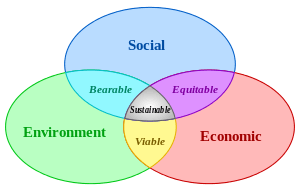Environmental stewardship
Environmental stewardship refers to responsible use and protection of the natural environment through conservation and sustainable practices. Aldo Leopold (1887–1949) championed environmental stewardship based on a land ethic "dealing with man's relation to land and to the animals and plants which grow upon it."[1]
Resilience-based ecosystem stewardship
Resilience-Based Ecosystem Stewardship emphasizes resilience as a basic feature of the changing world as well as ecosystems that provide a suite of ecosystem services rather than a single resource, and stewardship that recognizes resource managers as an integral part of the systems they manage.[2] Resilience refers to the ability of a system to absorb disturbance and still maintain its basic function and structure.[3]
Different types of environmental stewards
There are 3 types of environmental stewards: doers, donors, and practitioners. Doers go out and does help the cause by taking action. For example, the doers in an oil spill would be the volunteers that go along the beach and help clean up the oil from the beaches. A donor is the person that financially helps the cause. They can do anything from donating their money, to having galas or other fundraisers. They are typically governmental agencies. Lastly there are practitioners. They work on a day-to-day basis to steer governmental agencies, scientists, stakeholder groups, or any other group toward a stewardship outcome. Together these 3 groups make up environmental stewards and with the help keep the ecosystem running healthily.[4] Anybody can be an environmental steward by being aware and knowledgeable of the world around them and making sure they do as little as possible to negatively impact our world. Without these groups it would be hard to get any sort of sustainability in our increasingly technology, pollution, industrial based world. [5]
See also
- Environmental protection
- Environmental stewardship (England)
- Evangelical environmentalism
- Stewardship
- Stewardship (theology)
References
- ↑ Leopold, Aldo. 1949. A Sand County Almanac. Oxford University Press, New York.
- ↑ Chapin, F. Stuart III, Gary P. Kofinas, and Carl Folke (eds). 2009. Principles of Ecosystem Stewardship: Resilience-Based Natural Resource Management in a Changing World. Springer. ISBN 978-0387730325.
- ↑ Walker, Brian, and David Salt. 2006. Resilience Thinking: Sustaining Ecosystems and People in a Changing World. Island Press. ISBN 978-1597260930.
- ↑ Increasing Capacity for Stewardship of Oceans and Coasts, P. 30
- ↑ National Research Council. (2008). Increasing Capacity for Stewardship of Oceans and Coasts. The National Academic Press, 500 Fifth Street, NW Washington DC 20001.

